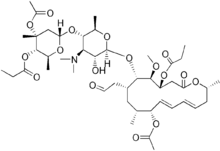Miocamycin
Miocamycin is a macrolide antibiotic.[1] It has a spectrum activity similar to that of Erythromycin, but shows higher antimicrobial effect against certain bacteria including Legionella pneumophila (the causative agent of Legionnaires' Disease), Mycoplasma hominis, and Ureaplasma urealyticum.[1] In-vivo studies have further expounded on Miocamycin's efficacy, reporting that the medication is more effective than in-vitro data suggests.[2]
 | |
| Clinical data | |
|---|---|
| AHFS/Drugs.com | International Drug Names |
| ATC code | |
| Identifiers | |
IUPAC name
| |
| CAS Number | |
| PubChem CID | |
| ChemSpider | |
| UNII | |
| ChEMBL | |
| CompTox Dashboard (EPA) | |
| ECHA InfoCard | 100.054.418 |
| Chemical and physical data | |
| Formula | C45H75NO15 |
| Molar mass | 870.087 g·mol−1 |
| 3D model (JSmol) | |
| Melting point | 220 °C (428 °F) |
| Solubility in water | Slightly soluble in water; Soluble in methanol, acetone and chloroform. mg/mL (20 °C) |
SMILES
| |
InChI
| |
| (verify) | |
References
- Holliday SM, Faulds D (October 1993). "Miocamycin. A review of its antimicrobial activity, pharmacokinetic properties and therapeutic potential". Drugs. 46 (4): 720–45. doi:10.2165/00003495-199346040-00008. PMID 7506653.
- Lyseng-Williamson, Katherine A (June 2006). "Miocamycin is an effective option in the treatment of various bacterial infections:". Drugs & Therapy Perspectives. 22 (6): 1–6. doi:10.2165/00042310-200622060-00001. ISSN 1172-0360.
This article is issued from Wikipedia. The text is licensed under Creative Commons - Attribution - Sharealike. Additional terms may apply for the media files.